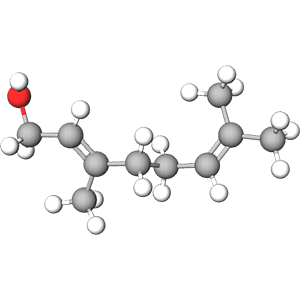

Geraniol is a sweet, floral-scented compound naturally occurring in rose oil, palmarosa oil, and citronella oil. It is highly valued in perfumery for its rose-like scent and ability to blend well with other fragrances. Geraniol is also found in flavorings and personal care products, offering antibacterial and antiseptic benefits.
Utilized in perfumes to create or enhance floral scents, especially rose. Also used in flavorings and as an antibacterial agent in personal care products.
IUPAC Name: (2E)-3,7-dimethylocta-2,6-dien-1-olCAS Number: 106-24-1
Molecular Formula: C10H18O
Molecular Weight: 154.25 g/mol
Boiling Point: 230 °C (446 °F)
Melting Point: -15 °C (<5 °F)
Class: Monoterpene Alcohol
Use/s: Scent
Synonyms
1: GERANIOL 2: Geranyl alcohol 3: Lemonol 4: trans-Geraniol 5: (E)-3,7-Dimethylocta-2,6-dien-1-ol 6: (E)-Geraniol 7: (2E)-3,7-dimethylocta-2,6-dien-1-ol 8: (E)-Nerol 9: trans-3,7-Dimethyl-2,6-octadien-1-ol
Chemist Says
Geraniol is a colorless to pale yellow oily liquid with a sweet rose odor. (NTP, 1992)
Scent: Sweet Rose, Geranium
Scent profile
Scent profiles are inherently subjective and can significantly differ among individuals, and may also be influenced by the conditions at the time of evaluation. The information provided here is a synthesis of data from diverse sources, including books, cross-references, artificial intelligence analyses, and chemical research sites, aiming to present a comprehensive overview. We've distilled this information to highlight the most frequently observed scent profiles for each molecule or compound, offering a generalized perspective.
1: Sweet, Floral, Rose-like
2: Floral, Rose, Citrus
3: Sweet rose odor
 Irritant
Irritant